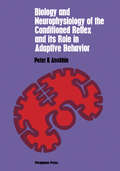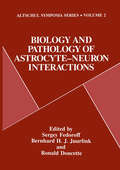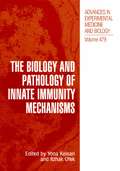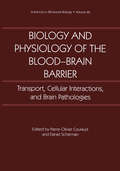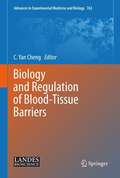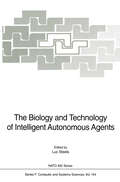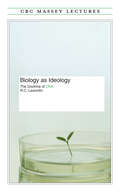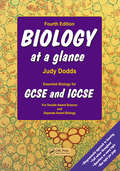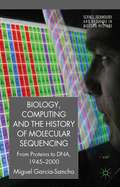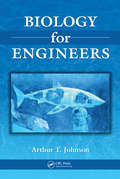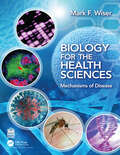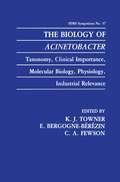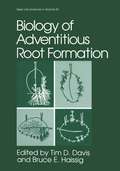- Table View
- List View
Biology and Neurophysiology of the Conditioned Reflex and Its Role in Adaptive Behavior: International Series of Monographs in Cerebrovisceral and Behavioral Physiology and Conditioned Reflexes, Volume 3
by Peter K. AnokhinBiology and Neurophysiology of the Conditioned Reflex and its Role in Adaptive Behavior explores the conditioned reflex, its historic development, and its functions and roles. The book also aims to bridge the gap between the integrative level of higher nervous activity and fine detailed neurophysiological investigations, giving light to the basis of the term “learning". The book, as an introduction, covers the biological roots of the conditioned reflex and the nature of the unconditioned reflex, then moves on to the different bases, hypotheses, and theories of both the coupling of the conditioned reflex; the physiological architecture of the behavioral act; the mechanism of action and function of conditioned inhibition function; and certain correlations in the study of this phenomenon. The text is recommended for biologists, zoologists, psychologists, and neuroscientists from different backgrounds who wish to know more about how the conditioned reflex, and ultimately learning, came about.
Biology and Neurophysiology of the Conditioned Reflex and Its Role in Adaptive Behavior: International Series of Monographs in Cerebrovisceral and Behavioral Physiology and Conditioned Reflexes, Volume 3
by Peter K. AnokhinInternational Series of Monographs in Cerebrovisceral and Behavioral Physiology and Conditioned Reflexes, Volume 3: Biology and Neurophysiology of the Conditioned Reflex and its Role in Adaptive Behavior focuses on the biological roots, characteristics, and nature of conditioned reflex and its function in adaptive behavior. The monograph first discusses the biological roots of the conditioned reflex. Concerns include sequential order of external influences and living protoplasm; anticipatory processes of protoplasm and the conditioned reflex; adaptive features of the conditioned reflex; and inborn signalization in higher animals. The book then takes a look at the nature of the unconditioned reflex, including biological nature of reinforcement; value of the temporal relationships of conditioned and unconditioned reflexes; and fixation of sequential order without the factor of reinforcement. The text describes systemogenesis as an evolutionary basis for the development of unconditioned reflexes; concepts concerning the nature of the coupling process; and hypothesis of the convergent coupling of the conditioned reflex. The book also examines functional system as a basis of the physiological architecture of behavioral acts. The monograph is a dependable source of data for readers interested in conditioned reflex and its function in adaptive behavior.
Biology and Pathology of Astrocyte-Neuron Interactions (Altschul Symposia Series #2)
by Sergey Fedoroff Bernhard H. J. Juurlink J. Ronald DoucetteThis volume is made up of papers presented at the Second International Altschul Symposium: Biology and Pathology of Astrocyte-Neuron Interactions. The symposium was held in Saskatoon, Canada at the University of Saskatchewn in May, 1992 in memory of Rudolf Altschul, a graduate of the University of Prague and a pioneer in the fields of the biology of the vascular and nervous systems. Dr. Altschul was Professor and Head of the Department of Anatomy at the University of Saskatchewan from 1955 to 1963. The Altschul Symposia were made possible by an endowment left by Anni Altschul and by other contributions. The symposia are held biennially. One of the greatest challenges for present day scientists is to uncover the mechanisms of brain function. Although cellular anatomy of the nervous system has already been well outlined and indeed was delineated by the beginning of the century, experimental analysis of the function of the brain is relatively recent. The framework of the brain is made up of stellate cells, the astrocytes, which are interconnected by means of their processes, thus presenting a meshwork through which the neurons send their axons, accompanied by oligodendrocytes. Microglia are distributed throughout the brain.
The Biology and Pathology of Innate Immunity Mechanisms (Advances in Experimental Medicine and Biology #479)
by Yona Keisari Itzhak OfekIn recent years increased scientific attention has been given to immediate defense mechanisms based on non-clonal recognition of microbial components. These mechanisms constitute the innate immunity arm of the body s defense. Identification of pathogens by these mechanisms involves primarily receptors recognizing sugar moieties of various microorganisms. Innate immunity based mechanisms are essential for the existence of multicellular organisms. They are evolutionarily conserved and designed to provide immediate protection against microbial pathogens to eradicate infection. Activation of innate immunity is crucial for transition to specific immunity and for its orientation, and to assist the specific immune response in the recognition of pathogens and their destruction. Innate immunity is regularly involved in the arrest of bacterial, mycotic, viral and parasitic infections, giving the specific immune response time to become effective. It becomes critically essential in immunocompromised patients who fail to mount specific immune responses due to congenital or acquired immunodeficiencies as a result of chemotherapy, dialysis, immunosuppressive drugs, or HIV infection. The Innate Immunity arsenal constitutes polymorphonuclear and mononuclear phagocytes, mast cells, the complement system, Natural Killer cells, antimicrobial peptides, and presumably a subset of T lymphocytes with TCRl receptors.
Biology and Pathology of Perineuronal Satellite Cells in Sensory Ganglia (Advances in Anatomy, Embryology and Cell Biology #226)
by Ennio PanneseThis volume provides a comprehensive and updated review of perineuronal satellite cells in sensory ganglia. For a long time since their discovery by Valentin in the first half of the 19th century these cells received only modest attention. However, some years ago research findings suggested that satellite cells play a role in the development and maintenance of neuropathic pain. As a result, satellite cells are now considered as possible targets for neuropathic pain treatment. Thus, interest in satellite cells has burgeoned. The review is based on the author’s own work as well as on his critical evaluation and systematic arrangement of data scattered through a large number of research papers. The following aspects of perineuronal satellite cells are covered: Shape and structure; molecular characteristics; origin and development; biological and functional properties; relationships with the ganglion sensory neuron; age-related changes; roles under physiological conditions; reactions to experimental and pathological conditions; role in neuropathic pain.
Biology and Physiology of the Blood-Brain Barrier: Transport, Cellular Interactions, and Brain Pathologies (Advances in Behavioral Biology #46)
by Pierre-Olivier Couraud Daniel SchermanThe endothelial cells of the cerebral vasculature constitute, together with perivascular elements (astrocytes, pcricytes, basement membrane), the blood-brain barrier (BBB), which strictly limits and specifically controls the exchanges between the blood and the cerebral extracellular spacc.The existence of such a physical, enzymatic, and active barrier isolating the central nervous system has broad physiological, biological, pharmacological, and patho logical consequences, most of which are not yet fully elucidated. The Cerebral Vascular Biology conference (CVB '95) was organized and held at the "Carre des Sciences" in Paris on July I 0-12, 1995. Like the CVB '92 conference held in Duluth, Minnesota, three years ago, the objectives were to provide a forum for presentation of the most recent progresses and to stimulate discussions in the ticld of the biology, physiology. and pathology of the blood-brain barrier. The Paris conference gathered more than !50 participants. including investigators in basic neuroscience, physicians. and stu dents, who actively contributed to the scientific program by their oral or poster presentations. This volume contains a collection of short articles that summarize most of the new data that were presented at the conference. Six thematic parts focus on physiological transports. drug delivery, multidrug resistance P-glycoprotein, signal transduction at the BBB. interactions between the immune system and the cerebral endothelial cells, and the blood-brain barrier-related pathologies in the central nervous system. In addition, two introductory articles present new insights in the rapidly evolving topics of cerebral angiogenesis and gene transfer to the brain.
The Biology and Prevention of Aerodigestive Tract Cancers (Advances in Experimental Medicine and Biology #320)
by Guy R. Newell Waun Ki Waun Ki HongThe papers contained in this volume were presented ati the Golden Jubilee Cancer Prevention Conference, "The Biology and Prevention of Aerodigestive Tract Cancers," sponsored by The University of Texas M. D. Anderson Cancer Center in Houston, Texas, February 21-23, 1991. The purpose of the conference was to further the understanding of the biology, epidemiology, and prevention of aerodigestive tract cancers. Advances in under standing the biology of aerodigestive tract cancers have led to successful early chemoprevention trials. Chemopreventive agents in current use are capable 9f reversing premalignant lesions, as well as reducing the number of second primary cancers of the head and neck. These trials hold the promise that effective prevention methods for these cancers will be forthcoming in the foreseeable future. Carcinogenic exposures appear to affect the entiry epithelial lining of the upper aerodigestive tract, a phenomena described as "field cancerization. " This process contributes to the development of both synchronous and metachronous aerodigestive tract cancers. It also provides a sound rationale for the chemoprevention of these cancers. Animal models are important for identifying the critical components of field cancerization and for testing potentially new chemopreventive agents and regimens. The hamster lung carcinogen esis model and the hamster cheek model are discussed. Aerodigestive tract cancers account for about 20% of newly diagnosed invasive cancers. Cigarette smoking and alcohol consumption are the most important risk factors for these cancers.
Biology and Regulation of Blood‑Tissue Barriers (Advances in Experimental Medicine and Biology #763)
by C. Yan ChengThis book was written by many outstanding investigators who have spent decades to study different aspects of blood‑tissue barrier function. They have summarized some of the latest and fascinating development in their fields of research including the blood‑brain barrier, the blood‑retinal barrier, the gut barrier, the blood‑biliary barrier, the blood‑follicle barrier, the blood‑epididymis barrier, the blood‑testis barrier, the tight junction barrier in general as well as barriers in the female reproductive tract. Included are also chapters that focus on topics that are physiologically applicable to all blood‑tissue barriers. Many of these chapters also include information on specific human diseases, such as pathological changes of the gut barrier that cause bowel disorders resulting from inflammation of the epithelial lining in the intestine, and infertility in men as a result of disruption of the blood‑epididymal and/or blood‑testis barriers; and on new therapeutic approaches (e.g., drug delivery across the blood‑brain and the blood‑retinal barriers).
The Biology and Technology of Intelligent Autonomous Agents (NATO ASI Subseries F: #144)
by Luc SteelsThe NATO sponsored Advanced Study Institute 'The Biology and Tech nology of Intelligent Autonomous Agents' was an extraordinary event. For two weeks it brought together the leading proponents of the new behavior oriented approach to Artificial Intelligence in Castel Ivano near Trento. The goal of the meeting was to establish a solid scientific and technological foun dation for the field of intelligent autonomous agents with a bias towards the new methodologies and techniques that have recently been developed in Ar tificial Intelligence under the strong influence of biology. Major themes of the conference were: bottom-up AI research, artificial life, neural networks and techniques of emergent functionality. The meeting was such an extraordinary event because it not only featured very high quality lectures on autonomous agents and the various fields feeding it, but also robot laboratories which were set up by the MIT AI laboratory (with a lab led by Rodney Brooks) and the VUB AI laboratory (with labs led by Tim Smithers and Luc Steels). This way the participants could also gain practical experience and discuss in concreto what the difficulties and achievements were of different approaches. In fact, the meeting has been such a success that a follow up meeting is planned for September 1995 in Monte Verita (Switzerland). This meeting is organised by Rolf Pfeifer (University of Zurich).
Biology and Therapy of Acute Leukemia: Proceedings of the Seventeenth Annual Detroit Cancer Symposium Detroit, Michigan — April 12–13, 1984 (Developments in Oncology #33)
by Voravit Ratanatharathorn Frederick Valeriote Laurence BakerThis year notes two major changes in the annual Detroit Cancer Symposium. The first is our intention of selecting top ics of broad interest to the cancer community and examining the subject from both a basic laboratory and clinical viewpoint. In this way, the importance of both elements of cancer research are noted and the interplay between them emphasized. Further, we believe that Symposia such as this act to stimulate the basic scientist and clinician to continue their studies with the know ledge of the impact that each has upon the other and the nec essary cooperation required to solve the cancer problem. The second change is the publication of this Symposium. The pre vious sixteen were not committed to manuscript form. Given the change in format and intent of the series, we believe that this and subsequent volumes will make important contributions to the cancer literature. The topic of "Biology and Therapy of Acute Leukemia" was chosen for the first Symposium because of its historical signif icance in cancer chemotherapy. The therapeutic rationale for human leukemia is the result of understanding the basic tumor biology largely derived from transplantable leukemias in exper imental animals. It is through these models, as discussed by Dr. Fred Valeriote, that we learned the cellular kinetics of leukemia, the antileukemic effects of new agents and the ef fect of growth perturbation by various chemotherapeutic agents and their combinations.
Biology and Treatment of Colorectal Cancer Metastasis: Proceedings of the National Large Bowel Cancer Project 1984 Conference on Biology and Treatment of Colorectal Cancer Metastasis Houston, Texas — September 13–15, 1984 (Developments in Oncology #42)
by Anthony J. MastromarinoThe theme of the current workshop was identified several years ago and was considered by the working group of the National Large Bowel Cancer Project to be an appropriate workshop topic. Although the subject was important then, it was not possible to conduct such a workshop at that time. In the interim, not only did the problems associated with colorectal metastasis still exist, but new insights on the biology and treatment of colorectal cancer metastasis emerged, making the workshop topic especially important and relevant. With input from an expert Planning Committee, a unique program was designed to provide an opportunity for information exchange between basic scientists and clinical investigators. The published proceedings reflect the organization of the workshop which consisted of five sections: Section I. The Biology of Colorectal Cancer Metastasis co-chaired by Drs. J. Isaiah Fidler and George Poste Controversies in the Management of Patients with Colorectal Cancer Section II.
Biology and Treatment of Leukemia and Bone Marrow Neoplasms (Cancer Treatment and Research #181)
by Vinod Pullarkat Guido MarcucciThis book provides a concise update on current understanding of the biology of acute and chronic leukemias and other bone marrow neoplasms, including myelodysplastic and myeloproliferative disorders, and explores new and emerging treatments. There is a particular focus on the molecular abnormalities that are drivers of leukemia and on their detection by modern molecular techniques. Knowledge of the ways in which genomic and metabolic abnormalities in the hematologic neoplasms affect prognosis and treatment decision making is reviewed. Detailed attention is devoted to targeted therapies, including novel drugs, and to potential targets for future drug development. In addition, readers find in-depth discussion of cellular and antibody-based immunotherapies as well as the role of hematopoietic stem cell transplantation in the treatment of leukemias and bone marrow malignancies. The book is of special interest for hematologists, oncologists, and cancer researchers; it is also of value for hematology trainees and medical students.
Biology As Ideology: The Doctrine of DNA (The CBC Massey Lectures)
by Richard LewontinR. C. Lewontin is a prominent scientist -- a geneticist who teaches at Harvard -- yet he believes that we have placed science on a pedestal, treating it as an objective body of knowledge that transcends all other ways of knowing and all other endeavours.Lewontin writes in this collection of essays, which began their life as CBC Radio's Massey Lectures Series for 1990: "Scientists do not begin life as scientists, after all, but as social beings immersed in a family, a state, a productive structure, and they view nature through a lens that has been molded by their social experience… . Science, like the Church before it, is a supremely social institution, reflecting and reinforcing the dominant values and vices of society at each historical epoch."In Biology as Ideology Lewontin examines the false paths down which modern scientific ideology has led us. By admitting science's limitations, he helps us rediscover the richness of nature -- and appreciate the real value of science.
Biology at a Glance
by Judy DoddsThe fourth edition of a bestseller, this book presents, in a clear, concise, and visual way, the main biological content required by all the examining boards for both the GCSE Double Award Science and separate Biology Award, including IGCSE. It is also useful as an introductory guide for AS Biology. The fourth edition has been revised to include new material on industrial fermenters and their applications, plus additional material on flowering plants.
Biology, Computing, and the History of Molecular Sequencing: From Proteins to DNA, 1945-2000 (Science, Technology and Medicine in Modern History)
by M. García-SanchoSequencing is often associated with the Human Genome Project and celebrated achievements concerning the DNA molecule. However, the history of this practice comprises not only academic biology, but also the world of computer-assisted information management. The book uncovers this history, qualifying the hype and expectations around genomics.
Biology for Engineers
by Arthur T. JohnsonBiology is a critical application area for engineering analysis and design, and students in engineering programs must be well-versed in the fundamentals of biology as they relate to their field. Biology for Engineers is an introductory text that minimizes unnecessary memorization of connections and classifications and instead emphasizes concepts, t
Biology for Engineers, Second Edition
by Arthur T. JohnsonBiology is a critical application area for engineering analysis and design, and students in engineering programs as well as ecologists and environmentalists must be well-versed in the fundamentals of biology as they relate to their field. Biology for Engineers, Second Edition is an introductory text that minimizes unnecessary memorization of connections and classifications and instead emphasizes concepts, technology, and the utilization of living things. Whether students are headed toward a bio-related engineering degree or one of the more traditional majors, biology is so important that all engineering students should know how living things work and act. Emphasizing the ever-present interactions between a biological unit and its physical, chemical, and biological environments, the book provides ample instruction on the basics of physics, chemistry, mathematics, and engineering through a systems approach. It brings together all the concepts one needs to understand the role of biology in modern technology. Classroom-tested at the University of Maryland, this comprehensive text introduces concepts and terminology needed to understand more advanced biology literature. Filled with practical detailed examples, the book presents: Presents scientific principles relevant to biology that all engineers, ecologists and environmentalists must know A discussion of biological responses from the perspective of a broad range of fields such as psychology, human factors, genetics, plant and animal physiology, imaging, control systems, actuary, and medicine Includes end of chapter questions to test comprehension Provides updated material to reflect the latest research developments such as CRISPR. Introduces over 150 interesting application examples, incorporating a number of different engineering disciplines. Ties biological systems properties and behaviors to foundational sciences such as engineering sciences, chemistry, etc.
Biology for Health: Applying the Activities of Daily Living
by S. H. CedarThis textbook takes a unique approach by linking the elements of anatomy and physiology (A&P) with everyday activities we all do without thinking, the 'Activities of Daily Living' such as breathing or eating, in order to explain biological systems and making complex ideas and biological processes easier to understand and relate to practice. By connecting A&P with health, healthcare and wellbeing, the author's exceptional understanding of students' needs contributes to a comprehensive book.As an essential anatomy and physiology textbook that uses accessible language, everyday examples, and connects to your course, this is the ultimate companion to any student. Whether you're studying nursing, health, midwifery, paramedic science, or sport and exercise, this introductory text will offer a head start.
Biology for the Health Sciences: Mechanisms of Disease
by Mark F WiserBiology is central to our understanding of health and disease and to the development of effective treatments, and thus it is critical that health professionals have a solid grounding and knowledge comfort in the pathogenesis and mechanisms of disease processes. This innovative new textbook draws these topics together, providing an accessible introduction across four central disciplines - basic biology, biotechnology, non-infectious disease and infectious disease. Key Features: Provides students of biology and those going into health care professions with a strong foundation to understand the pathogenesis of disease at the molecular and cellular level Focuses on the etiology and pathophysiology of the major human diseases by body system, including diabetes and nutritional disorders, cardiovascular disease, neurodegenerative diseases, and cancer, aligned to medicine and health science course structure Covers mechanisms of infectious disease transmission, as well as disease pathophysiology, and considers the impact of antibiotic resistance Reviews the applications of biotechnology and genomics to human health in diagnosis and treatment, as well as to our understanding of disease and disease surveillance Each chapter contains a mini glossary of key terms and associated definitions, and review questions allow students to assess how much of the chapter they have understood Digital resources accompany the textbook, such as interactive quizzes for students to engage with and figure slides of the book's illustrations that instructors can use in lectures Enhanced throughout with plentiful illustrations, Biology for the Health Sciences is an essential companion for any student of the health sciences and for biological science students studying the causes of disease as part of a wider course.
Biology for the Health Sciences: Mechanisms of Disease
by Mark F WiserBiology is central to our understanding of health and disease and to the development of effective treatments, and thus it is critical that health professionals have a solid grounding and knowledge comfort in the pathogenesis and mechanisms of disease processes. This innovative new textbook draws these topics together, providing an accessible introduction across four central disciplines - basic biology, biotechnology, non-infectious disease and infectious disease. Key Features: Provides students of biology and those going into health care professions with a strong foundation to understand the pathogenesis of disease at the molecular and cellular level Focuses on the etiology and pathophysiology of the major human diseases by body system, including diabetes and nutritional disorders, cardiovascular disease, neurodegenerative diseases, and cancer, aligned to medicine and health science course structure Covers mechanisms of infectious disease transmission, as well as disease pathophysiology, and considers the impact of antibiotic resistance Reviews the applications of biotechnology and genomics to human health in diagnosis and treatment, as well as to our understanding of disease and disease surveillance Each chapter contains a mini glossary of key terms and associated definitions, and review questions allow students to assess how much of the chapter they have understood Digital resources accompany the textbook, such as interactive quizzes for students to engage with and figure slides of the book's illustrations that instructors can use in lectures Enhanced throughout with plentiful illustrations, Biology for the Health Sciences is an essential companion for any student of the health sciences and for biological science students studying the causes of disease as part of a wider course.
Biology, Medicine, and Surgery of Elephants
by Susan K. Mikota Murray FowlerElephants are possibly the most well-known members of the animal kingdom. The enormous size, unusual anatomy, and longevity of elephants have fascinated humans for millenia. Biology, Medicine, and Surgery of Elephants serves as a comprehensive text on elephant medicine and surgery. Based on the expertise of 36 scientists and clinical veterinarians, this volume covers biology, husbandry, veterinary medicine and surgery of the elephant as known today. Written by the foremost experts in the field Comprehensively covers both Asian and African elephants Complete with taxonomy, behavioral, geographical and systemic information Well-illustrated and organized for easy reference
Biology, Medicine, and Surgery of South American Wild Animals
by Zalmir S. Cubas Murray FowlerBiology, Medicine and Surgery of South American Wild Animals examines the medicine and treatment of animals specific to South America. It discusses topics dealing with diseases and biology topics. In addition, the animals studied are broken down into family and genus, using both English and Spanish names. The book is liberally illustrated and contains references for further reading as well as the contributions of regional experts on the animals covered.
The Biology of Acinetobacter: Taxonomy, Clinical Importance, Molecular Biology, Physiology, Industrial Relevance (F.E.M.S. Symposium Series #57)
by K. J. Towner E. Bergogne-Bérézin C. A. FewsonThe 1st International Workshop on Acinetobacter was held on 6th September, 1986, in Manchester, England, in association with the 14th International Congress of Microbiology. That occasion was so well attended and productive that there were soon discussions about how, when and where the next meeting should be held. This time, however, there was sufficient confidence to think of a more substantial meeting and to plan for the proceedings to be published. It emerged that there was wide agreement that the time was ripe to take stock of the entire biology of Acinetobacter: its occurrence and taxonomy; its molecular biology, biochemistry and physiology; its clinical importance and its industrial and commercial applications. The 2nd International Workshop on Acinetobacter took place from 6th to 7th September, 1990, at the Institut Pasteur, Paris, and was sponsored by the Federation of European Microbiological Societies. There were about 100 participants from 19 countries. The backbone of the meeting consisted of 23 plenary lectures. There were 28 posters and the meeting closed with a general discussion which went on long after the official finishing time despite all the counter-attractions of a sunny Parisian Friday afternoon. Indeed discussions continued while cruising along the Seine and while dining at the top of the Tour Montparnasse. However, the vitality and usefulness of even the most successful meeting is difficult to transmit by the printed word.
Biology of Adventitious Root Formation (Basic Life Sciences #62)
by Tim D. Davis Bruce E. HaissigCharles E. Hess Department of Environmental Horticulture University of California Davis, CA 95616 Research in the biology of adventitious root formation has a special place in science. It provides an excellent forum in which to pursue fundamental research on the regulation of plant growth and development. At the same time the results of the research have been quickly applied by commercial plant propagators, agronomists, foresters and horticulturists (see the chapter by Kovar and Kuchenbuch, by Ritchie, and by Davies and coworkers in this volume). In an era when there is great interest in speeding technology transfer, the experiences gained in research in adventitious root formation may provide useful examples for other areas of science. Interaction between the fundamental and the applied have been and continue to be facilitated by the establishment, in 1951, of the Plant Propagators' Society, which has evolved into the International Plant Propagators' Society, with active programs in six regions around the world. It is a unique organization which brings together researchers in universities, botanical gardens and arboreta, and commercial plant propagators. In this synergistic environment new knowledge is rapidly transferred and new ideas for fundamental research evolve from the presentations and discussions by experienced plant propagators. In the past 50 years, based on research related to the biology of adventitious root formation, advances in plant propagation have been made on two major fronts.
The Biology of Ageing: A Practical Handbook
by Gurcharan Rai Aza AbdullaOne of the problems geriatricians are confronted with in everyday clinical practice is differentiating disease from the process of old age. The challenges of ageing require a better understanding of the essential biology of ageing in order to separate ageing from disease, and indeed ageing made worse by disease. Although the topic is large and diverse, this practical and easy-to-read reference book contains vital information on the biology of ageing. It provides a concise understanding of the changes that occur and focuses on the clinical implications of ageing. MCQs are featured throughout for revision and examination practice. The Biology of Ageing provides the reader with: . a learning guide on the biology of ageing through an overview of the changes that occur at both cellular and system levels . knowledge of how biological changes of ageing impact on physiology and the clinical relevance in medical practice . a practical consideration of these changes in disease presentations and how these changes may impact on disease management. This full-colour guide featuring slides, MRIs, figures and photographs is ideal for doctors training in geriatric medicine, practising geriatricians and those with an interest in management of older people.
